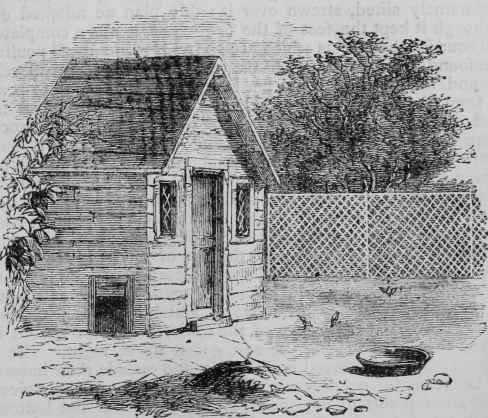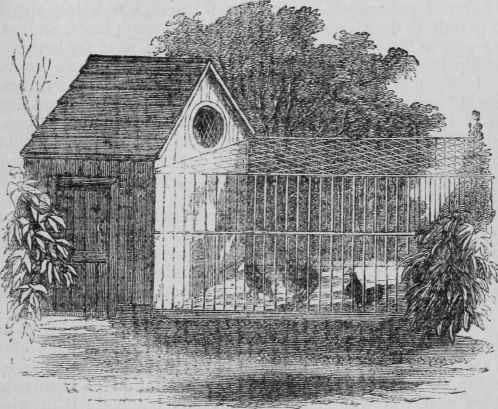The Poultry Yard
Description
This section is from the book "Warne's Model Housekeeper", by Ross Murray. See also: Larousse Gastronomique.
The Poultry Yard
There is no house, however small, with the very least possible piece of outlet, that may not, with a little care and trouble, indulge in the luxury of new-laid eggs, spring chickens, and fat poultry. We will try to show how, in an inexpensive manner and with ordinary care, the poultry-yard may prove a source of amusement as well as of profit.
Fowl House
Having decided on keeping fowls, the first thing to be done is to prepare a suitable place for their habitation. Of course the size of the fowl-house must depend upon the number you purpose keeping, and the number you purpose keeping must be regulated by the space at your command; but having decided the size to build your fowl-house, which, it possible, should have a south aspect, it is well to do so in as cheap a manner as possible. The most economical material for building is wood, the roof of the same covered with patent felt. This roofing measures thirty-two inches wide, and is 8d. a yard. It is water-tight, but should be placed over common boards, as it is apt to bag, and if water settles in the hollows it becomes rotten. It is nailed on with hot iron tacks heated in a frying-pan, and when it is up, it must be tarred and thickly sprinkled with sand, which should be repaired every year. In summer weather a felt-covered house is hot, therefore, if possible, it should be erected under the shadow of trees. It should be well ventilated, but you must avoid the least possibility of a draught.
The floor should be perfectly dry, and the roof, like our own houses, weather-tight. Sliding-windows or air-openings should be made at either end, so as to admit air in abundance, but so situated as not to expose the fowls to a current of air or draught when they are at roost. The perches should of course be round and not too slight - perhaps about the size of a rolling-pin; and the nearer they are to the ground for the heavy description of poultry the better. Having completed the fowl-house externally, the floor must be next attended to, and as cleanliness is of most particular importance in securing your fowls in health and beauty, too much attention cannot be paid to this part. There are many opinions as to the best flooring for a fowl-house, some recommending stone and bricks: both these are too cold; others, the ground well rammed, and ashes from the dust-hole, finely sifted, strewn over it: this plan we adopted ourselves, and although it kept the feet of the fowl clean, it was a complete nest of and harbour for the insects which are so troublesome to all poultry.
The best we found, after very many trials, was well-screened gravel well-beaten down; and, having a brickfield hard by, we were enabled to procure the refuse from the brick kilns thickly spread over the gravel and well rammed down also. Being thoroughly wetted during the process with good strong lime-water, it forms a description of concrete. It is of course necessary you should not mix your different varieties of fowl, otherwise you never can depend upon a pure breed, which to many is the very greatest desideratum; and to obtain that object you must adopt the following method: Necessarily you must divide your poultry-house into as many partitions as you intend to keep descriptions of poultry. These may be made of wire netting, and the run or yard divided in the same manner. Should the cocks prove troublesome and inclined to fight, boards or wire have to be used instead of netting. The whole of the run should be covered also with netting. Hatches must be made in the houses for the exit and entrance of the fowls, and these should be made to slide so that the fowls may be safely shut up at night. The greatest cleanliness must be observed both inside and outside their houses; baths should be cleaned if possible once a day - at the very least twice a week.
If space allow, a sort of day-shed may be erected at the bottom of the run, made up of any description of old rubbish, but sufficiently secure to prevent their escape, in which gravel, ashes, refuse of old buildings, and old mortar pounded may be thrown, so as to enable them to seek shelter from the weather without taking refuge in their roosting-place, and where they may also peck up what is so essential to their well-doing, without which they cannot digest their food, and where they can feather themselves.

A Simple Wooden or Felt-covered Fowl House.
Moveable houses are very excellent for fowls, as new earth is a great boon to poultry. If there is land enough to allow of a house of this kind being removed from time to time, the poultry will thrive all the better for it. Moveable fencing goes with these houses.

Bantam House for a Lawn.
Having fixed upon the description of fowls you purpose keeping, the very greatest care must be taken in their feeding. They should have sufficient, and no more than sufficient, food, but that which they have should be good. Very many people run away with the false impression that you cannot overfeed poultry: it is a grave error to do so. In feeding fowls throw the food to them, and while they are really hungry they will run after their food with avidity. When they begin to slacken or begin to eat daintily, stop feeding them. One essential of success in poultry-keeping is an abundant supply of clean water. Fowls are very particular about it. They also, like individuals, require a change of diet: their usual food is corn and meal of every description, small potatoes boiled and given hot, mixed with boiled barley meal, pollard, cayenne pepper seeds, a little Indian corn, crusts of bread fried in fat, and any cuttings of meat that may be tainted, or the refuse from making lard, will keep them laying the whole year round.
Continue to:


